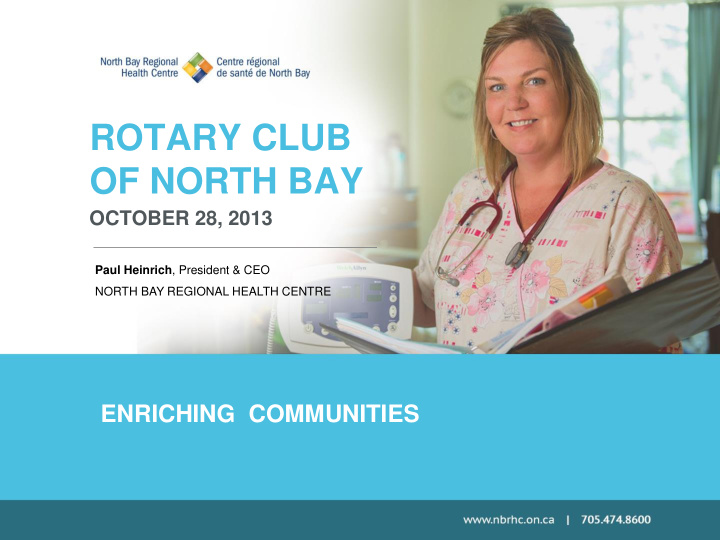



ROTARY CLUB OF NORTH BAY OCTOBER 28, 2013 Paul Heinrich , President & CEO NORTH BAY REGIONAL HEALTH CENTRE ENRICHING COMMUNITIES
THANK YOU In 2003 the Rotary Club of North Bay & Rotary Club of North Bay – Nipissing partnered to make a major commitment to our communities. • Your partnership made a $500,000 pledge to the building of the new Health Centre. • This commitment was completed in April 2008 through community fundraising events and member contributions. • The NICU is named for Rotary, recognizing your effort and dedication to our community’s health care. • Rotarians have provided their support to the Physician Recruitment & Retention program by hosting events for medical learners and supporting the department with member’s networking and resources .
NBRHC SERVICE AREAS District Hospital • District referral centre with specialists’ services for smaller community hospitals: Mattawa, West Nipissing, Temiskaming, Englehart, Kirkland Lake • Acute (schedule one) mental health and addictions services Regional Mental Health • Provides specialized mental health services to northeast Ontario: inpatient services in North Bay and Sudbury, outpatient and outreach services across the region. • Work closely with Schedule One hospitals in the region: Timmins, Sault Ste. Marie, Sudbury, NB
NBRHC FACTS • Health Centre Budget $232M • Number of employees 2300 • Number of inpatient days 130,095 • Number of acute beds 163 • Number of non-acute beds 257 • Total beds 420
FINANCIAL CHALLENGES • Overall Working Capital Deficit - $76M • Total 2013/14 Hospital Budget - $232M • Total Budget Cuts over the past 3 years — 25M (11%)
FINANCIAL STEWARDSHIP STRATEGIES Work efforts focused with our voluntary Operational Review and updated Strategic Plan Our strategy includes further budget reduction through revenue generating opportunities, cost of supplies and organizational restructuring. Some recent saving strategies include: – June 2013 parking increased by $1 to $3/hr, max of $6/day – Reduction in management staff – Matching staff to demand, staff reassignment – Managing inpatient population • Reducing Alternate Level of Care patients by 33% in past year • Reducing Number of Patients awaiting Long Term Care by 36% in past year • Length of stay for 70% of medical patients is equal to or better than the provincial average • Reducing occupancy rates from 100%+ in acute beds to 85%
Direction #1 ACCESS TO THE RIGHT CARE We will provide access to appropriate care • We often assume the hospital is the right place for a patient. The hospital can be the right place if the patient requires: – acute care – specialized treatment – active rehabilitation following an acute illness or surgery – or when the patient is too complex to be cared for on an ongoing basis in another environment. • The hospital’s role is to assist the patient to recover as soon as possible and to be discharged safely home. • ‘Home’ may be a retirement home, assisted living, supportive housing, group home or elsewhere in the community • Additional funding invested in the community and new Community Care Access Centre (CCAC) programs (Telehomecare and Rapid Response Nurses) help keep patients in the community.
Direction #1 ACCESS TO THE RIGHT CARE • Patients waiting for long term care in hospital wait longer than those in the community. • Last year 63% of patients we discharged home with additional CCAC services remained at home instead of progressing to long term care • Elderly patients who remain in hospital demonstrate a functional decline of 2.5- 5% per day. This may never be fully regained.
Direction #4 WISE CHOICES We will define, defend and maintain our core business Master Program For NBRHC • Reviewing the services the hospital provides over the next 5-10-20 years • Completed by end of the fiscal year (March 31, 2014)
LEAN ORGANIZATION Improve continuously towards perfection by identifying and removing waste while practising respect for people • Focuses on patients (not the hospital or staff) and designs care around them. • Identifies value for the patient and gets rid of everything else as much as possible (waste). • Minimizes time to treatment and through its course. Source: “On the Mend” by John Toussaint, MD and Roger Gerard, PhD
Direction #3 OUR PEOPLE ACHIEVING THEIR BEST We will implement the ‘More Time To Care” system to support continuous improvement More Time To Care System: A set of management behaviours and tools • Employed in every department • Makes continuous improvement (CI) a way of life • Sustains the gains from CI
Direction #2 PARTNERSHIPS WITH PURPOSE We will support the activities of the NBRHC Foundation NBRHC Pediatric Unit: • NBRHC will relocate four specialized pediatric mental health care beds from the Kirkwood campus in Sudbury • Part of a move to decentralize pediatric mental health beds to hub hospitals • Four specialized beds will be joined with the two existing acute care mental health beds to form a six bed child/adolescent mental health unit. NBRHC Pediatric Unit: $1.7M
Direction #2 PARTNERSHIPS WITH PURPOSE Central Fetal Monitoring System • “Real - time” assessment: monitoring 8 moms and babies, simultaneously, centrally, at any given moment. • Gives comprehensive medical information so that time-critical, life-saving decisions and interventions are made. Central Fetal Monitoring System: $1.25 million
QUESTIONS
Recommend
More recommend